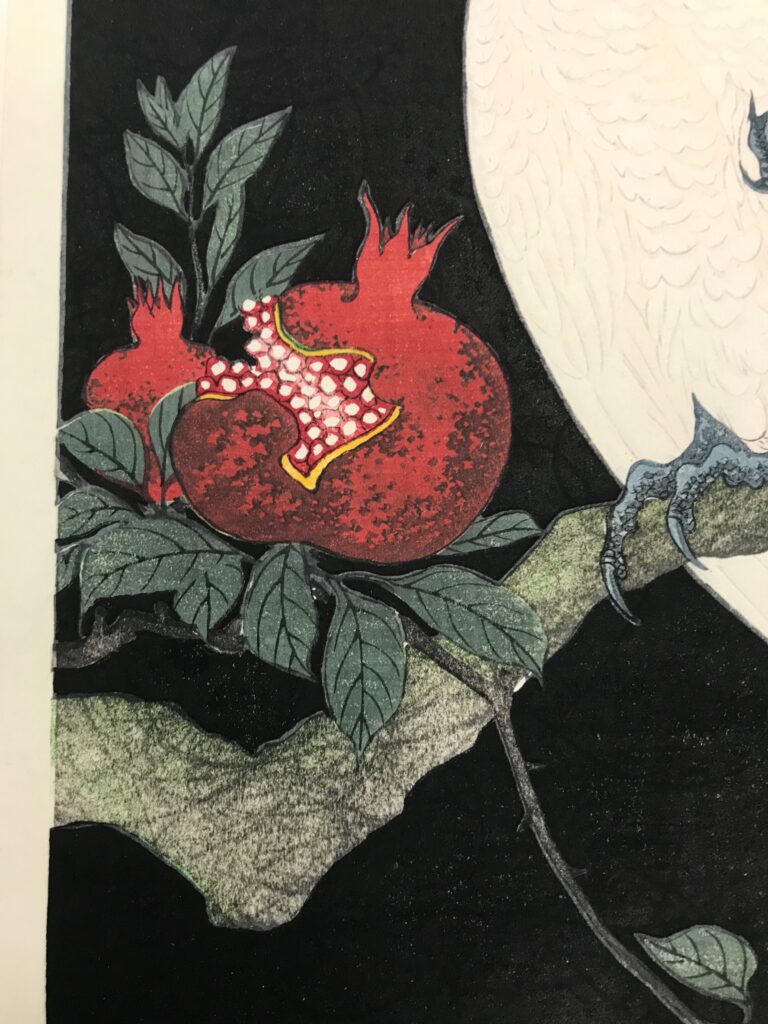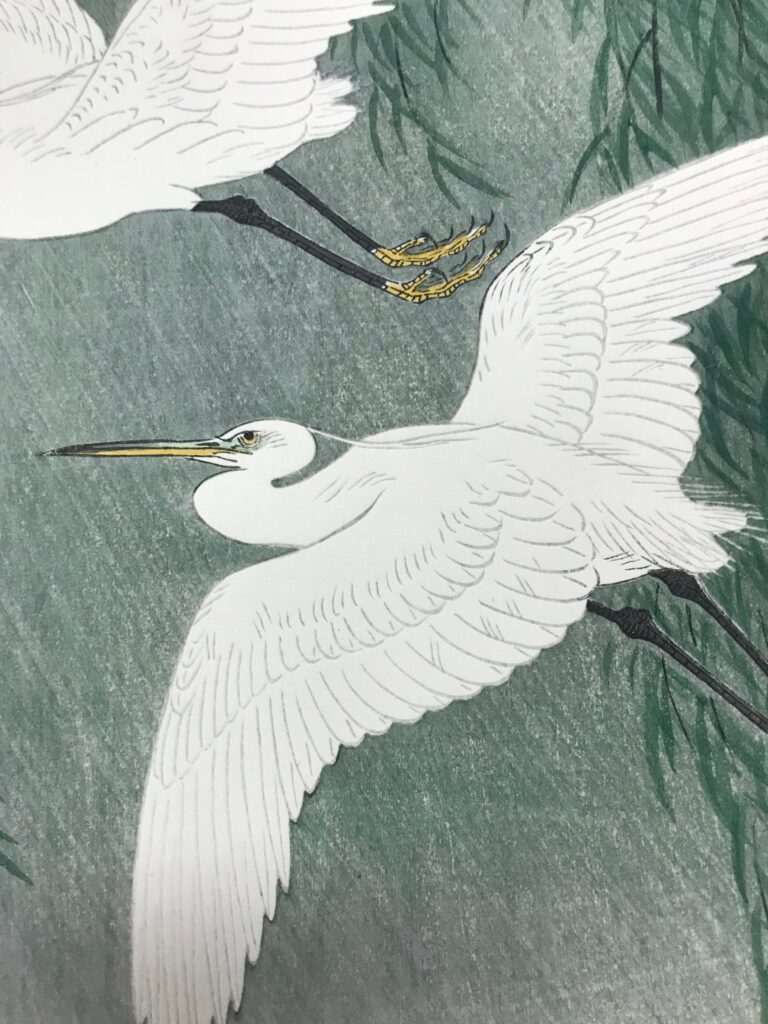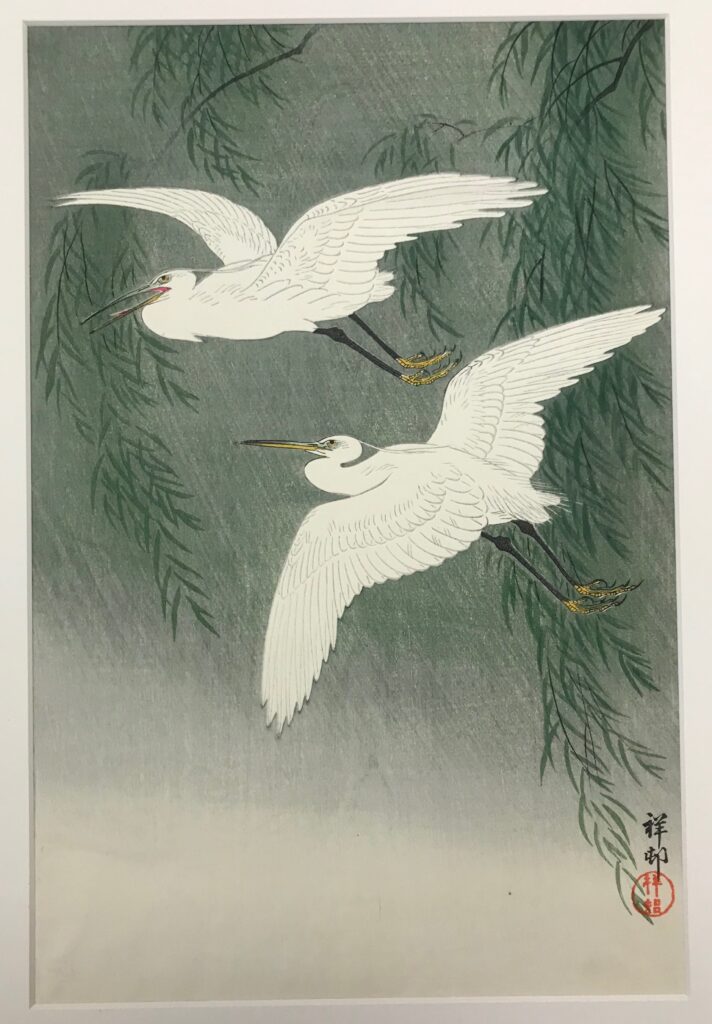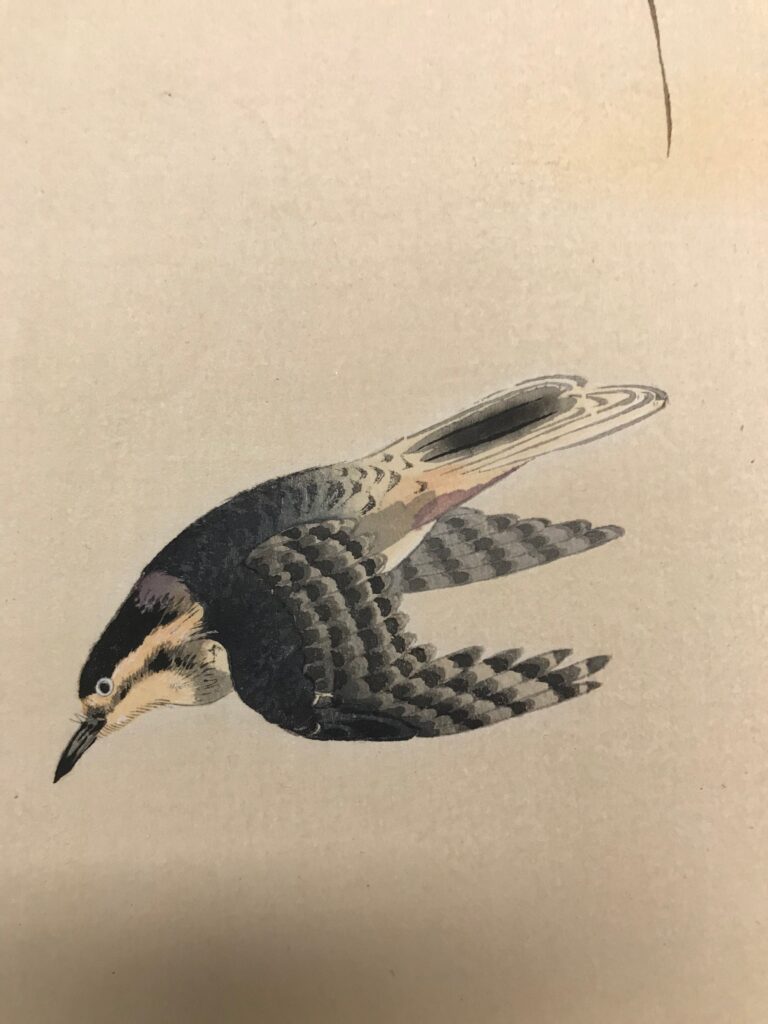OVERVIEW
As illustrations of both nature and spirit, kachō-e (花鳥絵) or kachō-ga (花鳥画) woodblock prints have have long been regarded as a distinctive aspect of Japanese culture and tradition. A subset of the ukiyo-e (浮世絵), or ‘picture of the floating world,’ genre, kachō-e can be translated literally as ‘bird-and-flower painting.’ Each print features birds as the main subject, showcasing how each bird interacts with the nature around them. The image of the kachō-e print has remained the same throughout centuries of production – there is a certain style, or tradition, attributed to the genre that has been transmitted across generations of artists. In each piece, there is a balance between naturalism and artifice, and a specific attention to detail afforded to the main subject in the foreground. The background is often neutral or ’empty’ to draw the viewer’s focus to the birds and flowers in the piece. The scenes painted depict a certain natural ‘spirit’ or emotion through the depiction of seasons, through the motions of the birds, and through the texture of the brushwork.
This exhibition features prints that showcase how the tradition of kachō-e has been kept alive, even through ages of rapid technological change. We begin first by looking at 19th century works created by well-known ‘masters’ of the genre, Hokusai and Hiroshige. Each print, while featuring different birds in vastly different environments, adheres to the set of rules discussed above – the textured feathers on the birds and minimalistic backgrounds are distinctive aspects of each piece. We then compare these works to those of 20th century artist Ohara Koson. Although Koson’s prints were produced nearly a century after those of the genre’s ‘innovators,’ it is easy to see how the brushwork and composition kachō-e is known for has been transmitted. Each Koson print can easily be related back to pieces showcased earlier in the exhibit.
The difference in these pieces lies less within the style they were painted in and more in the production method used in their distribution. Due to the opening of the country to the Western world during the Meiji period beginning in the mid-19th century, technologies were introduced (such as photography and film) that competed directly with the Japanese woodblock medium. However, the introduction of the West to the country also brought with it the opening of a new market for this art form – there was an increase in interest among foreigners in woodblock prints as ‘artistic,’ ‘historic,’ and ‘exotic.’ With their depiction of the natural world and natural decorative appeal, bird-and-flower prints in particular had many Western buyers hoping to add pieces to their collection. Publishers, hoping to capitalize on this foreign interest in kachō-e (particularly in the works of artists such as Hiroshige and Hokusai), commissioned contemporary artists for new works intended ‘primarily for export.’ As one of these artists, Koson’s name is primarily associated with kachō-e, both in Japan and abroad. Because of new production methods, Koson’s work was able to be produced for cheaper, sold for cheaper, and ‘mass-produced’ with a Western audience in mind – however, despite this modern method of production, Koson drew upon on the works and traditions of previous artists to inform his own art. Koson’s works ensured that the tradition of the genre lived on, while also appealing to the Western desire for Japanese aesthetic, ‘technical perfection,’ and ease of accessibility.
(As a part of my research in the creation of this exhibition, I had the privilege of being able to view the Koson prints in-person at Connecticut College. The fact that I was able to interact with these prints like this speaks, at least somewhat, to their accessibility. In addition, being able to view the prints in-person allowed me to better view the visual qualities of each one – the texture of the pieces in particular stood out to me far more than when I viewed them online, with each bird seeming to pop from their respective piece. I have included multiple pictures of each print that I took in this exhibition – while they do not capture the experience of seeing the pieces for oneself, I hope that the distinct characteristics of kachō-e that I saw are visible.)
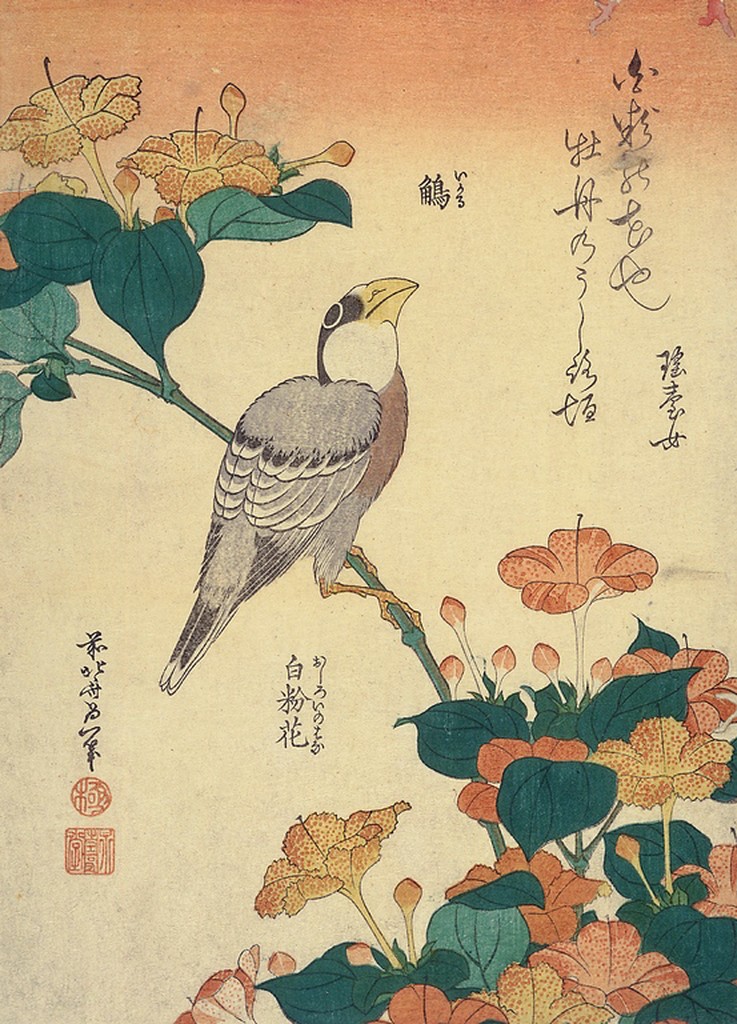
Culture: Japanese
Title: Grosbeak and Oshiroi
Work Type: Drawings and Watercolors
Date: 1825 – 1830
Material: Ink on paper
Measurements: 9.5 x 7 in.
Repository: The Minneapolis Institute of Art
Minneapolis, Minnesota, USA
Bequest of Richard P. Gale
74.1.203
Description: This Hokusai piece features a Japanese grosbeak perched atop an oshiroi-bana, or four o’clock flower. While the grosbeak itself is painted in mostly neutral colors, this is contrasted by the warmth of its surroundings – the vibrant red-orange of the oshiroi-bana is highlighted by the cool blue-green of the stem and leaves surrounding the flowers, while the background features an orange gradient at the top of the piece fading into more of a beige color. True to the traditional kachō-e style, the background is extremely minimalistic, drawing viewer’s eyes to the vitality of the bird and flowers in the foreground. While the piece features no shading, there is a specific attention to detail paid to the feathers of the grosbeak and the textured flowers of the oshiroi-bana – both subjects are also given a thin black outline, making them pop from the empty space around them.
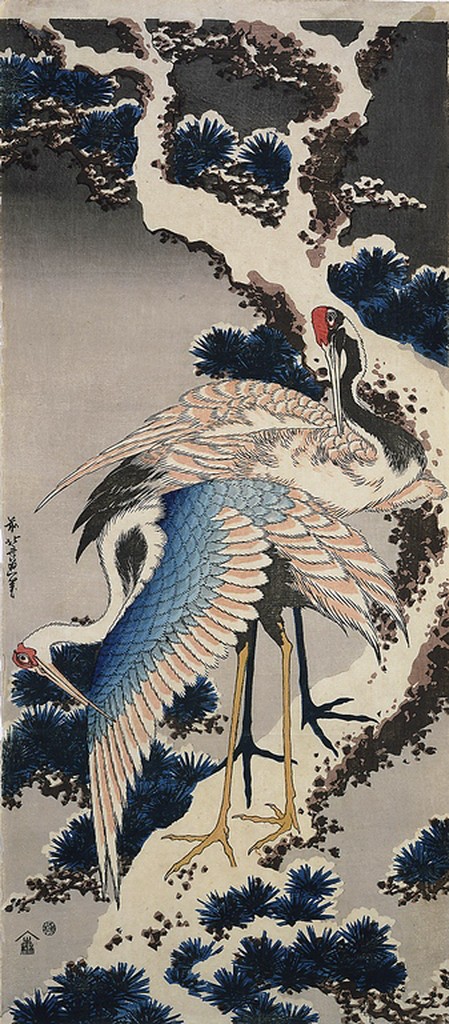
Culture: Japanese
Title: Two Cranes on a Snowy Pine
Work Type: Prints
Date: 1830 – 1835
Material: Color woodblock print
Measurements: 20 1/2 x 9 1/8 in.
Repository: The Minneapolis Institute of Art
Minneapolis, Minnesota, USA
Bequest of Richard P. Gale
74.1.241
Description: With its dark, cool color palette, ‘Two Cranes on a Snowy Pine’ is able to evoke the atmosphere of a tranquil, quiet winter season. The background begins with a dark gray gradient, which slowly fades into a lighter shade – never loosing the hint of gray coloring throughout. While the rich blue of the pine leans more towards artifice than naturalism, its coloration adds to the sense of calm created by the pieces ‘coolness.’ The snow-covered pine itself is not the main subject of the piece – while it has been painted in detail, it lacks the dark outline that Hokusai gave to the pair of cranes perched atop it. Each of the cranes’ wing and tail feathers have been outlined and textured, giving them a soft appearance. In addition, the cranes feature the only warm colors of the piece – the crane in the foreground displays the yellow coloration of its legs, while both feature a vibrant splash of red atop their heads.

Culture: Japanese
Title: Untitled (Cuckoo and Iris)
Work Type: Prints
Date: 1847 – 1848
Material: Color woodcut
Measurements: 33.5 x 11.4 cm
Repository: Fine Arts Museums of San Francisco
San Francisco, California, USA
Katherine Ball Collection
1964.141.633
Description: In this Hiroshige print, the main focus is the action and movement of the main subject, the cuckoo. The cuckoo itself instantly draws in the eyes of viewers – while its neutral coloration is similar to that of the background behind it, the brushwork of the feathers and the swooping motion being made by its body make it stand out from the rest of the piece. The isis, while vibrantly colored with purple and green, does not feature the same amount of texture as the cuckoo. Instead, its swaying motion accentuate’s the cuckoo’s downward motion. While minimalistic, the gradients in the background also inform viewer’s of the cuckoo’s actions. The hint of red at the top of the piece quickly fades out – as one’s gaze moves downwards, the far thicker line of blue fades in. This choice of color is able to tell a story; this cuckoo is swooping over a stretch of water, perhaps at sunset.
Culture: Japanese
Title: Untitled (Cockatoo and pomegranate)
Work Type: Color woodcut
Date: 1927
Material: Ink on paper
Measurements: 37 x 23 cm
Repository: Wetmore Print Collection, Art History Dept, Cummings Arts Center, Connecticut College, New London
Donated by Prof. Caroline Black, Botany Dept, Connecticut College
(Photographs by Hana Tanabe)
Description: This Koson piece is distinct in that the background does not feature a gradient. Instead, all of the negative space is completely black, ensuring that the subject, a snowy white cockatoo, pops out to the eyes of viewers. While the background is dark and empty, the foreground evokes a strong sense of vitality, and the scene feels ‘lived in.’ The rough brushstrokes texturing the branch that the cockatoo rests on emulate the roughness of bark (and, perhaps, communicate the fact that it has seen the claws of many birds in the past), and the bright red pomegranate is bitten into, light reflecting off the seeds inside. The cockatoo itself is given the most texture in the piece, each white feather being outlined with a soft brushstroke.
Culture: Japanese
Title: Untitled (Egrets in rain)
Work Type: Color woodcut
Date: 1926
Material: Ink on paper
Measurements: 37 x 24 cm
Repository: Wetmore Print Collection, Art History Dept, Cummings Arts Center, Connecticut College, New London
Donated by Prof. Caroline Black, Botany Dept, Connecticut College
(Photographs by Hana Tanabe)
Description: Both the background and the foreground contribute the sense of motion that this Koson piece conveys. The background is a dull green gradient that fades slowly to grey, then to off-white at the bottom of the print. The diagonal lines etched into the green gives the appearance of rain steadily falling, while the fading of the gradient appears to be a mist rising up from unseen water. The hanging branches in the background, while not the subject of the piece (as can be seen by the lineless, loose brushstrokes used to illustrate them), sway in the same diagonal direction the rain falls in – this, along with the forward movement of the egrets, evokes a sense of wind and movement. The egrets themselves pop out in the sea of green, their white feathers given a soft outline to distinguish them from the background of the piece.
Culture: Japanese
Title: Untitled (Diving bird)
Work Type: Color woodcut
Date: Unknown
Material: Ink on paper
Measurements: 35 x 19 cm
Repository: Wetmore Print Collection, Art History Dept, Cummings Arts Center, Connecticut College, New London
Donated by Prof. Caroline Black, Botany Dept, Connecticut College
(Photographs by Hana Tanabe)
Description: While this Koson print features very little color that might pop out to a viewer’s eyes, the main focal point of the diving bird is enough to communicate the vitality and spirit of the piece. The background is mostly empty, with a small section of dull orange gradient at the top of the print – however, hints of this orange coloration can be seen as the eye travels down the piece, the background evoking the sense of the sky behind the action. The bird features the widest variety of color (a dull orange, red, and blue) and texture in the piece, ensuring that it draws in the eyes of its viewer. The bird is diving down, perhaps toward the water, while the hanging foliage of the plant seem to emphasize the bird’s downward motion. The feathers of the bird are highly textured, while the leaves of the plant are painted with a flat color – this, again, places the emphasis on the action of the bird.
BIBLIOGRAPHY
Images & Labels
- Katasushika Hokusai, Asian; Far East Asian; Japanese, 1760 – 1894, (artist),. 1825 – 1830. Grosbeak and Oshiroi. Drawings and Watercolors. Place: The Minneapolis Institute of Art, Minneapolis, Minnesota, USA, Bequest of Richard P. Gale, 74.1.203, http://www.artsmia.org/. https://library.artstor.org/asset/AMICO_MINIAPOLIS_103820925 (access to Artstor required).
- Katsushika Hokusai, Asian; Far East Asian; Japanese, 1760 – 1849, (artist),. 1830 – 1835. Two Cranes on a Snowy Pine. Prints. Place: The Minneapolis Institute of Art, Minneapolis, Minnesota, USA, Bequest of Richard P. Gale, 74.1.241, http://www.artsmia.org/. https://library.artstor.org/asset/AMICO_MINIAPOLIS_103820956 (access to Artstor required).
- Katsushika Hokusai, Asian; Far East Asian; Japanese, 1760 – 1849, (artist),. 1830 – 1835. Two Cranes on a Snowy Pine. Prints. Place: The Minneapolis Institute of Art, Minneapolis, Minnesota, USA, Bequest of Richard P. Gale, 74.1.241, http://www.artsmia.org/. https://library.artstor.org/asset/AMICO_MINIAPOLIS_103820956 (access to Artstor required).
- SHOSON, Japanese. c.1927. Untitled, cockatoo & pomegranate. color woodcut. Place: Wetmore Print Collection, Art History Dept, Cummings Arts Center, Connecticut College, New London, Donated by Prof. Caroline Black, Botany Dept, Connecticut College. https://library.artstor.org/asset/CONNASIAN_106310758464 (access to Artstor required).
- SHOSON, Japanese. c.1926. Untitled, egrets in rain. color woodcut. Place: Wetmore Print Collection, Art History Dept, Cummings Arts Center, Connecticut College, New London, Donated by Prof. Caroline Black, Botany Dept, Connecticut College. https://library.artstor.org/asset/CONNASIAN_106310758425 (access to Artstor required).
- KOSON, Japanese. Untitled, diving bird. color woodcut. Place: Wetmore Print Collection, Art History Dept, Cummings Arts Center, Connecticut College, New London, Donated by Prof. Caroline Black, Botany Dept, Connecticut College. https://library.artstor.org/asset/CONNASIAN_106310758424 (access to Artstor required).
Texts
- Newland, Amy Reigle., Jan. Perrée, and Robert. Schaap. Crows, Cranes & Camellias : the Natural World of Ohara Koson 1877-1945 : Japanese Prints from the Jan Perrée Collection Leiden: Hotei Pub., 2001.
- Harkins, William E. “SHIJŌ BIRD, ANIMAL AND FLOWER PRINTS IN THE MEIJI PERIOD.” Impressions, no. 12 (1986): 10–12. http://www.jstor.org/stable/42597689.
- Putney, Carolyn M., Kendall H. Brown, Shūko Koyama, Paul Binnie, and Brian P. Kennedy. Fresh Impressions : Early Modern Japanese Prints Toledo: Toledo Museum of Art, 2013.
